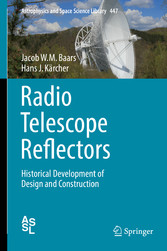Suchen und Finden
Service
Radio Telescope Reflectors - Historical Development of Design and Construction
Jacob W.M. Baars, Hans J Kärcher
Verlag Springer-Verlag, 2017
ISBN 9783319651484 , 282 Seiten
Format PDF, OL
Kopierschutz Wasserzeichen
Preface
7
Contents
10
Chapter 1: Introduction
14
Chapter 2: Evolution of the Telescope
21
2.1 Some History
22
2.1.1 Early Optical Telescope Efforts
22
2.1.2 Emergence of Electromagnetic (Radio) Waves
25
2.2 General Characteristics of Optical and Radio Telescopes
27
2.2.1 Introduction
27
2.2.2 Types of Telescope Mount and Optics
30
2.2.3 Alternative Geometrical Configurations
33
2.3 Technological Challenges for Radio Telescopes
34
2.4 Basic Specifications of a Reflector Radio Telescope
35
2.4.1 Reflector Precision
36
2.4.2 Pointing Precision
36
2.5 Summary
37
Addendum: Geometry of Optical Configuration
38
References
42
Chapter 3: Birth of Radio Astronomy
43
3.1 Early History of Radio Telescopes
44
3.1.1 Jansky´s Bruce Antenna
44
3.1.2 Reber´s Transit Paraboloidal Reflector
44
3.1.3 Würzburg Riese Radar Antenna
46
3.2 The First Large Radio Telescopes
48
3.2.1 Dwingeloo (NL) and Stockert (BRD) Telescopes
49
3.2.1.1 Dwingeloo
49
3.2.1.2 Stockert
51
3.2.2 A Comment on Accessibility of the Focal Point
54
3.2.3 Jodrell Bank (UK): Lovell Telescope (76 m)
54
3.2.4 Parkes (Australia) 64 m Telescope
59
3.2.5 NRAO (USA): 140-ft and 300-ft Telescopes
62
3.2.5.1 NRAO 140-ft Equatorial Telescope: An Expensive and Slow Project
64
3.2.5.2 NRAO 300-ft Transit Telescope: A Cheap and Quick Deal
67
3.2.6 The 120-ft Haystack Antenna of MIT Lincoln Laboratory
69
3.3 Conclusion
72
References
72
Chapter 4: Structural Design of Reflector Antennas: Homology
74
4.1 Introduction
75
4.2 The Design of Homologous Structures
75
4.3 The Design of a 65-m Homologous mm Telescope
81
4.4 The Effelsberg 100-m Radio Telescope
84
4.4.1 The German Proposal for a Giant Radio Telescope
84
4.4.2 A Comment on the Homologous Behaviour of a Structure
86
4.4.3 The Industrial Design Proposals
86
4.4.4 The Final Design and Realisation
89
4.5 Backup Structure and Deformation Patterns
91
4.5.1 The Design Approach of the Effelsberg Backup Structure
92
4.5.2 Interpretation of the Load Cases of the Effelsberg Reflector
95
4.5.2.1 Zenith Position
95
4.5.2.2 Horizon Position
96
4.5.3 Load Case Superposition
97
4.5.4 The Deformation Behaviour of the Effelsberg Reflector
98
4.5.5 Performance Limits of the Effelsberg Reflector Principle
103
4.6 Four-Point Reflector Support
106
4.6.1 Introduction
106
4.6.2 The Westerbork Array of 25-m Antennas
107
4.6.3 The MERLIN Antenna with a Perfect Four-Point Support
109
4.6.4 The Joined Four-Point Support of the IGN 40-m Telescope
114
4.7 Conclusion
117
References
117
Chapter 5: Emergence of Millimetre-Wavelength Telescopes
118
5.1 Into mm Wavelengths
119
5.2 The NRAO 36-ft Antenna
120
5.3 The IRAM 30-m Telescope (MRT)
123
5.3.1 Introduction: Performance Specification
123
5.3.2 The Design Selection
125
5.3.3 The Structural Concept of the MRT
129
5.3.4 The Deformation Behaviour of the MRT
132
5.3.4.1 Load Case in Zenith Position
132
5.3.4.2 Load Case in Horizon Position
133
5.3.4.3 The Deformation Behaviour of the Final Improved Design
133
5.3.5 Overall Surface Error of the Actual Telescope
136
5.3.6 Thermal Effects and Their Control
137
5.3.7 Conclusion
142
5.4 The Large Millimeter Telescope
143
5.4.1 Conceptual Design Phase
143
5.4.2 Towards a Final LMT Design
146
5.4.3 The Final Design of the LMT/GTM
147
5.4.4 Short Review of Surface Panel Technology
150
5.4.5 The Isostatic Reflector Segments of the LMT
151
5.4.6 Flexible Body Control (FBC)
152
5.4.7 Concluding Remark on the LMT/GTM
154
5.5 The Nobeyama 45-m Millimeter Telescope
155
5.6 Conclusion
156
Addendum: Thermal Effects and Their Control
156
References
162
Chapter 6: Submillimetre-Wavelength Telescopes
164
6.1 Introduction
165
6.2 Leighton Dish and CSO Telescope
166
6.3 CFRP Telescopes: IRAM 15-m and HHT
168
6.3.1 The IRAM Interferometer Antennas
168
6.3.2 The Heinrich Hertz (Submillimeter) Telescope (HHT)
170
6.4 Atacama Large Millimeter Array (ALMA) Antennas
173
6.4.1 Introduction
173
6.4.2 Test Program and Performance of the ALMA Prototype Antennas
176
6.4.3 Remark on the Circular BUS/ELC Interface Concept
179
6.4.4 Comparison of the Designs from AEM/EIE and Vertex
181
6.4.4.1 Comparison of Structural Design
181
6.4.4.2 Weight
184
6.4.4.3 Deformation Behaviour
185
6.4.4.4 Interpretation of the Astigmatism from Basic Structural Mechanics
186
6.4.4.5 Comparison of the Bearing and Drive Systems
190
6.4.4.6 Dynamic Behaviour, Structural Resonance Frequencies
191
6.4.5 Conclusion
192
References
194
Chapter 7: Alternative Reflector Geometries
195
7.1 Telescopes with Fixed Main Reflectors
196
7.2 The Giant Metrewave Radio Telescope (GMRT) in India
200
7.3 Large Horn Antennas
201
7.4 Offset Reflector Antennas
202
7.4.1 Introduction
202
7.4.2 Allen Telescope Array (ATA)
204
7.4.3 MeerKAT and Square Kilometre Array (SKA)
205
7.4.4 Green Bank Telescope (GBT)
208
Addendum: Remarks on Wheel-On-Track Systems
213
References
217
Chapter 8: Electromagnetic Aspects of the Reflector Antenna
218
8.1 Introduction
219
8.2 Radiation Pattern of a Circular Aperture
220
8.3 Major Parameters of the Reflector Antenna
222
8.4 Influence of Imperfections on Performance
224
8.4.1 Illumination, Spillover and Polarisation Efficiency
224
8.4.2 Radiation Efficiency
226
8.4.3 Small-Scale Surface Error (Scattering) Efficiency
226
8.4.4 Large-Scale Deformation: Representation by Zernike Polynomials
229
8.4.5 Blocking Efficiency
231
8.4.6 Lateral and Axial Defocus: Gain Loss
233
8.4.7 Beam Deviation Factor (BDF)
236
8.4.8 Conclusion
236
8.5 Measuring Antenna Parameters with Cosmic Sources
237
8.5.1 Antenna Gain and Beam Pattern
237
8.5.2 Antenna Pointing
238
8.6 Radio Holographic Measurement of Reflector Profile
240
8.7 Progress in Electromagnetic Design
242
8.7.1 Historical Introduction
242
8.7.2 Radio Astronomy and Communication Approaches Differ
243
8.7.3 Exploiting the Focal Plane
244
8.7.3.1 Multi-feed System with Independent Pixels
244
8.7.3.2 Phased-Array Feeds (PAF)
245
8.8 Conclusion
246
Addendum: Aberrations and Zernike Polynomials
247
References
250
Chapter 9: Concluding Review and a Dialogue on Management Aspects
252
9.1 Concluding Review
253
9.2 A Dialogue on Management Aspects
260
9.2.1 Customer and Contractor
261
9.2.2 Project Management and System Engineering
262
9.2.3 Technological Aspects
263
9.2.4 Industrialisation Aspects, Costs
264
9.2.5 Manufacturing in Foreign Countries
265
9.2.6 Product Delivery, Commissioning
266
Acronyms and Abbreviations
268
Glossary
271
Name Index
274
Subject Index
278



